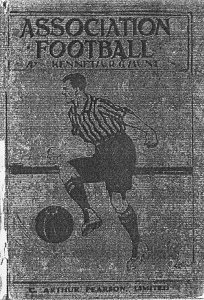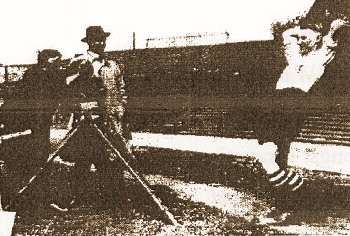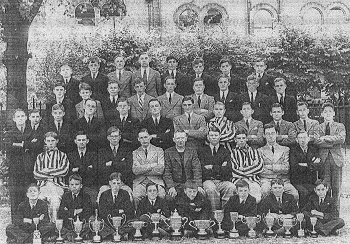|
Chapter 6.
Highgate School
Kenneth Hunt commenced his teaching
career at Highgate School, London in the September of 1908.
There is little doubt that he would have
been well aware of the school's reputation, not only because
of it being a well established Anglican foundation, but also
because he had spent quite a few of the formative years of
his childhood in the nearby London district of Islington.
However, despite this, there is no evidence that he had
actually attended the school as a pupil before moving to
Wolverhampton in 1898. Hunt joined the staff of Highgate at
the same time as Dr. J.A. Johnston, the school's new
Headmaster took up his appointment. Johnston's reign as Head
of Highgate was to last for almost three decades, and he has
been described as "one of the great public school
Headmasters of this century".
Under Johnston's leadership the school
thrived and prospered, and its reputation was greatly
enhanced. Kenneth Hunt played no small part in the growth of
Highgate's fortunes during the period. Due to his
considerable national fame in 1908, it is likely that Hunt
was initially appointed to Highgate as a Games Master,
although he later taught a variety of subjects, including
English and History, and was to subsequently assume other
roles within the school. Johnston seems to have been a
particularly shrewd man in promoting the image of his
school, and although he may not have been party to Hunt's
appointment, undoubtedly he was grateful for the publicity
the footballer was to bring to the establishment. A former
pupil, Brigadier Arthur A. Sissons (retired), who was at the
school between 1938 and 1943, states that this was
definitely the reason why his father chose Highgate as the
place for his son's education.
|

| Cover of booklet
"Association Football" by Kenneth Hunt. (published in
the late 1920s). |
|
"KRGH was the main reason I went to
Highgate. my father was a keen footballer, Wolves was his
local team and KRGH was his schoolboy idol. Later he went to
Queen's Oxford, following KRGH's footsteps in continued
admiration. And so I was sent to Grindal house in September
1938; house colours black and gold - what else!"
The Headmaster's positive attitude to
sports is underlined in a history of Highgate, which notes
that, "Dr. Johnston delighted in triumphs on the games
field", and in later years Johnston even wrote articles on
the theory and practice of the game of cricket. The common
and shared philosophy on the role and value of sport which
existed between the two men would undoubtedly have benefited
Hunt, as the Head's attitude and support were critical in
ensuring that the young man made a sound start to his
teaching career.
|
|
Indeed, upon the outbreak of the Great
War in 1914 Johnston held such a high opinion of Hunt's
organising ability and the regard that the boys had for him,
that he was appointed Lieutenant to the school's Officer
Training Corps, which was attached to the 3rd Volunteer
Battalion of the Middlesex Regiment. Undoubtedly in later
years, when the excitement and novelty of war were a mere
memory, Hunt would have reflected upon his relationship with
the numerous pupils he helped to train who subsequently died
in action on the battlefields of the Western Front, and also
the teaching colleagues who left Highgate and met a similar
fate. Even so Hunt pursued this role with his usual
enthusiasm, even after hostilities ceased. He was promoted
to the rank of Captain, ('Officer Commanding') of the Corps
in 1919; a position which he held until he became School
Chaplain in 1923. Even then his involvement with the young
soldiers of Highgate did not end. He instituted the 'Hunt
Cup' for Drill proficiency, which was contested by the
Corps' members for many years. It may seem rather
incongruous that a 'man of the cloth' such as Hunt should
take up military duties with the O.T.C. at the school, but
undoubtedly he saw this as his duty in a time of war.
Brigadier Sissions underlines this point when he describes
Hunt's attitude as "stern, competitive and above all,
honourable in the full "British Empire" sense of the word".
|
| Hunt was a man of his time and there appears to
be little doubt that he would have answered the 'call to the
colours', as did so many of his friends and colleagues at that
time, if he had not actually been an Ordained Minister.
However, despite speculation on this point, it does seem
that the Officer Training Corps provided boys who were not
good at sport with a way of developing a respectful
relationship with the popular cleric. |

| Hunt as technical
advisor in an F.A. instructional film in 1935. The
player is Gardener of Aston Villa. |
|
| Another former pupil, Geoffrey Hucks, who
describes himself as "rather a 'swot' and never a footballer",
rose to the rank of Sergeant in the Corps, and because of the
experience and respect he gained from drilling under Hunt kept
in touch with him after he had left school. Mr. Hucks describes
Kenneth Hunt as "one of the few masters I admired." Kenneth Hunt
was a figure and personality that loomed so large in the eyes of
the young lads, that incredibly ex-pupils can readily call to
mind details of the man, even after a lapse of eight decades in
some instances. Mr. Sydney Rothman, who entered Highgate in
1910, and would have been one of Hunt's first pupils, describes
him as a rather striking figure, who "would have made an
excellent model for a portrait painter, or a sculptor”.
He recalls Hunt as being a firm, but
somewhat disinterested disciplinarian, who dispensed "50 or
a 100 lines" to boys reported to him for misdemeanours with
the instruction "Don't do it again!" The Reverend Charles
Skene Catling recalls Kenneth Hunt as always having a cane
on his desk, whilst he got on with making the pupils
remember as much Latin Grammar as possible. He adds that he
thought the cane was “more of a symbol than for use, though
his discipline was firm.”
In his biography (entitled “Unless I'm
very much mistaken") published in 2002, the famous motor
sport broadcaster, Murray Walker, recalled Hunt's use of the
cane somewhat differently. He writes that on one occasion
whilst being taught by Kenneth Hunt, he was ordered to the
front of the class to be punished for what he saw as some
trivial misdemeanour The Master said, "I'm going to give you
three strokes, Walker, but before I administer justice, have
you got anything to say in mitigation?" "Yes Sir!", the boy
replied" I thought you would be interested to know that I
will be the second generation of Walkers you have beaten
because you beat my father." "Oh did I?" Hunt said" Well now
I'm going to give you six for that!" Murray Walker said that
this incident taught him not to be cocky and to keep his
mouth shut in difficult circumstances!
|
|

Kenneth Hunt and Grindal House members
in 1934. |
On Hunt's teaching ability, Reverend Catling
concludes that he was "not perhaps a great scholar, but he would
accept neither poor work nor bad behaviour." Hunt's popularity
with the boys was very evident in those early days at Highgate.
Mr. Rothman remembers KRGH "striding down Hampstead Lane,
surrounded by a swarm of 'Boney Brothers' (pupils), There were
only two brothers, but they guarded their hero so successfully
that - to me - they seemed like a dozen. |
|
In 1920 the number of boys enrolling as
boarders had increased so much that the school instituted a
new 'House' which was named after the Anglican Bishop,
Grindal. Hunt became the first House master of Grindal, and
his influence and personality is still evident on that
institution today, five decades after his death. Hunt was
determined that his house should excel in sport, as one
might expect. His sentimentality and regard for his past is
evident from his choice of colours for Grindal House,
because he selected none other than 'old' gold and black,
the same ones he had sported whilst a player with
Wolverhampton Wanderers a decade earlier. Boys of Grindal
House still wear these famous colours for sporting
activities. It represents a strange but lasting reminder of
the affection felt by their founder for the Club with which
he achieved so much.
Grindal House is unique amongst such
institutions in English public schools, since it is the only
one which has its own old boys association. Hence the
uniqueness Hunt instilled into Grindal at its outset is
still evident today. The earlier part of the period between
the wars not only saw a marked increase in the number of
boys entering Highgate, but also a comparable expansion in
sports facilities. During this period the school produced a
number of internationally known sporting personalities who
would have been instructed by Kenneth Hunt. Notable amongst
these were A.H. Fabian, R.W.V. Robins and W. H. Webster.
Aubrey Fabian, who was to represent his
country in amateur football international matches, and
received an F.A. (Amateur) Cup Winners medal with the
Casuals in 1936, (something which Hunt himself had been
unable to achieve with Oxford City in 1912). He also played
for the Derby County side which got to the semi-final of the
F.A. Cup in 1933. After the Second World War, Fabian
published works on the history of football and the F.A., and
eventually his link with Kenneth Hunt was re-established
when he became Housemaster of Grindal in 1955. Robert Robins
gained his fame on the cricket, rather than the football
pitch, although he did represent Highgate at soccer whilst a
pupil in the early 1920's. Robins captained both Middlesex
and England in the last decade before the Second World War.
William Webster also gained an Amateur Cup medal with the
Casuals in 1936 and became the Honorary Treasurer of the
M.C.C. After the Second World War, like Hunt, he too became
a member of the F.A. Council.
The personality and bearing of Kenneth
Hunt maintained his reputation amongst generations of boys
who were not aware of his footballing exploits first hand,
and one commentator summed up the relationship thus; "To
many boys... the obvious reaction to the word 'Grindal' was
'Hunt'." Legends came to exist about Hunt within the
folklore of Highgate, and one example was when he bounced a
'Fives' ball off a classroom wall onto the back of the head
of a pupil whose full attention the Reverend gentleman
wished to engage. Perhaps this happened on occasion, but
many came to believe that it was a feat that Hunt could
execute at anytime he wished. It is unlikely that he would
deny it.
Kenneth Hunt strongly believed in what is
now termed 'extra-curricular activity' and regularly took
boys camping on the Isle of Mull in Scotland. Perhaps he
modelled these 'expeditions' on the activities of Reverend
G.S. Warner, his opposite number at Trent College. There is
a danger of thinking that Hunt was only concerned with the
physical and spiritual development of his pupils, but there
was more to his approach to education than this. He
attempted to give the boys of Highgate, who were by and
large the sons of wealthy and prosperous families, an
insight into the lives of the poorer people of London.
Through Hunt, the school was involved with what would be
termed now 'an inner city mission' which was located in
Dalston. Hunt regularly took boys down to this school
mission where they shared in social activities with their
working class counterparts in the Boys' Club.
Half a century on the school still has
some contact with the church at Dalston, but changing social
attitudes and facilities mean that the Club which Hunt
worked so hard to establish no longer functions. None the
less, it would certainly have broadened the educational and
social experience of Highgate boys especially during the
slump of the 1930's. Despite their own fairly secure
backgrounds, they would have met lads of their own age, who
would experience daily the depravation and hardship that
abounded in such parts of London at that time.
It was around about this time that
Kenneth Hunt wrote an instruction booklet for young players
entitled "Association Football". In this compact and
informative tome he not only dealt with tactics and
positional play, but also promoted a cerebral approach to
the game. "A somewhat lengthy experience of school football
has assured me that while there are plenty of young players
who possess the natural attributes of a footballer, there
are very few who realise the need of a clever conception of
the game. Brains play a very big part indeed in football,
which is by no means always to the fast and the strong."
In 1929 Hunt became the Second Master (or
Deputy Head) of Highgate School, a position he was to hold
until his retirement in 1945. In the Lent Term of 1933 Hunt
deputized for Johnston who took a sabbatical to go on an
ocean cruise to South Africa, but whether he had thoughts of
applying for the post on a permanent basis when the latter
retired in 1936 are not known. What is known is that he
played a key role in maintaining the education of 400 of
Highgate's boys when they were evacuated to the Devonshire
resort of Westward Ho! during the Blitz on London. During
this fraught time Hunt would have had to comfort many lads
whose fears and anxieties compounded the usual difficulties
of going through adolescence. His pastoral care not only
reached the pupils, but also fellow staff. Hunt and his wife
took a young Master called Theodore Mallinson into their
home and made the difficulty of being away from family and
usual surroundings a little easier to bear.
It is hardly surprising when one
considers his energy that Hunt managed to find time to do a
little relief preaching in churches in the locality of the
town whilst resident in Westward Ho! (Hunt had developed an
interest in boating before the War, but upon the outbreak of
hostilities his craft was commandeered by the Government and
later used for evacuating troops from Dunkirk.)
Upon re-establishing the school back in
London in 1943, Grindal House was put to use as the school's
sanatorium, although Hunt's own direct involvement with
Highgate was to last only a short while longer. It seems
that he suffered "some serious illness at Westward Ho!", but
the exact nature of the malady is unclear from existing
records. He experienced a fall whilst on night-time Air Raid
Precaution duty in 1944, and this caused him some discomfort
in his last few months at the school. These events led Hunt,
now in his 61st year to 'take things more easily', and apply
for retirement.
He finally retired in the July of 1945.
The old boy's organisation, 'the Old Cholmeleans' organised
an appeal from amongst their members to institute a lasting
tribute to the man who had served them and the school for
more than three decades.
The following tribute to R.K.G. Hunt was
written in the 'Old Cholmelean' magazine at the time, and
sums up well his contribution to Highgate and the image he
portrayed to those at the school:
"Memories are fragrant flowers, and there
are so many of K.R.G.H., propping up the mantelpiece in the
Common Room, erecting the guillotine in the Common Room,
erecting the guillotine in the old 2B classroom, dominating
a First Club game, but perhaps most of all in 'footer bags'
and Oxford visor, doing 'this job' and about the garden.
This is how we shall hope to see him in his new home at
Heathfield in Sussex, where we wish Mrs. Hunt, to whom the
school also owes so much, and himself, a long and happy
retirement."
Hunt and his wife May, finally settled
down to a life of retirement at a large detached house
called 'Edgehill', Tillsmore Rd. in the East Sussex town of
Heathfield in August 1945, although they still visited the
school on the occasions that they 'went up to town' after
this time.
|

|

|

|
Return
to
Chapter 5 |
Return
to
the contents |
Proceed
to
Chapter 7 |
|